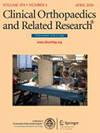Can Nutritional and Inflammatory Markers Be Combined to Develop an Accurate Survival Model for Surgical Decision-making in Patients With Lung Cancer Bone Metastases?
IF 4.4
2区 医学
Q1 ORTHOPEDICS
引用次数: 0
Abstract
BACKGROUND Targeted and immunotherapies have improved the survivorship of patients with lung cancer and bone metastases. However, most existing models were developed during the chemotherapy era and do not accurately reflect survival outcomes in the current therapeutic context, leading to limited clinical applicability. Additionally, a wide range of inflammatory and nutritional markers has been identified as useful for cancer survival assessment. The most effective selection or combination of these markers for evaluating survival in patients with lung cancer and bone metastases, especially within the framework of modern multimodal treatments, has not yet been systematically investigated. QUESTIONS/PURPOSES (1) What combination of inflammatory and nutritional markers can better evaluate survival in patients with lung cancer and bone metastases? (2) Can an accurate lung cancer-specific bone metastasis model be constructed by integrating the above marker combination with the latest advancements in targeted and immunotherapies to guide clinical decision-making? METHODS Between January 1, 2019, and June 1, 2024, we treated 319 patients with bone metastases from lung cancer at Guangdong Provincial People's Hospital, a tertiary academic medical center in Guangzhou, PR China. We considered patients with severe pain, pathological fracture, skeletal instability, or spinal cord/nerve compression as potentially eligible. Of the potentially eligible patients, 7% (23 of 319) were excluded due to repeated admissions, 4% (14 of 319) declined surgical intervention, 0.6% (2 of 319) died within 1 week postoperatively, 0.6% (2 of 319) were lost before the minimum follow-up period, and 0.3% (1 of 319) had incomplete datasets, leaving 87% (277 of 319) of patients for analysis. Of those, 277 underwent surgical procedures, including open spinal decompression (44% [123 of 277]), tumor resection with replacement or internal fixation (25% [68 of 277]), and minimally invasive procedures (31% [86 of 277]). The mean age was 61 ± 11 years, and 63% (174 of 277) of patients were male. The most common histological subtype was adenocarcinoma (82% [228 of 277]), followed by squamous cell carcinoma (14% [38 of 277]). Bone metastases primarily involved the spine (65% [179 of 277]), limbs (22% [62 of 277]), and pelvis (10% [28 of 277]). Candidate variables were selected using stepwise regression based on the minimum Akaike information criterion, and their associations with survival were assessed using Cox regression and restricted cubic splines. A nomogram was developed and validated through calibration curves, a decision curve analysis, and internal validation via bootstrap resampling. Discrimination was assessed through time-dependent receiver operating characteristic (time-ROC) analysis to calculate the area under the curve (AUC). RESULTS This study identified the systemic inflammation response index (systemic immune-inflammation index [SIRI], neutrophil count × monocyte count/lymphocyte count [all in 109 cells/L]) and prognostic nutritional index (PNI) (albumin [g/L] + 5 × lymphocyte count [109 cells/L]) as associated factors. Specifically, female sex (HR 0.68 [95% confidence interval (CI) 0.48 to 0.96; p = 0.03), fewer bone metastases (< 3 versus ≥ 3, HR 0.62 [95% CI 0.43 to 0.91]; p = 0.01), higher Eastern Cooperative Oncology Group (ECOG) score (0 to 2 versus 3 to 4, HR 0.58 [95% CI 0.41 to 0.83]; p = 0.003), higher PNI (HR 0.96 [95% CI 0.94 to 0.99]; p = 0.02), and first-line treatment (targeted or immunotherapy versus chemotherapy, HR 0.59 [95% CI 0.42 to 0.83]; p = 0.002) were independently associated with improved survival, whereas higher SIRI (HR 1.04 [95% CI 1.01 to 1.08]; p = 0.01) indicated decreased survival. The bootstrap calibrated AUCs were 0.81 (95% CI 0.76 to 0.89), 0.83 (95% CI 0.77 to 0.88), and 0.82 (95% CI 0.77 to 0.88), for 3-, 6-, and 12-month survival, respectively. Calibration curves illustrated good agreement between estimated and observed survival rates, and the decision curve analysis validated the clinical applicability across diverse risk thresholds. The final models were developed into an online application, which is available at https://lbp-apps.shinyapps.io/lbp-app. CONCLUSION As inflammatory and nutritional markers, PNI and SIRI exhibit great value in assessing survival time for patients with lung cancer and bone metastases. The addition of immunotherapy and targeted therapy has notably improved survival outcomes. By incorporating variables such as sex, the number of bone metastases, ECOG performance status, and first-line treatment, the model provides a reliable tool for guiding surgical decision-making. LEVEL OF EVIDENCE Level III, prognostic study.营养和炎症标志物能否结合起来,为肺癌骨转移患者的手术决策制定一个准确的生存模型?
背景:靶向和免疫治疗提高了肺癌和骨转移患者的生存率。然而,大多数现有模型是在化疗时期开发的,不能准确反映当前治疗背景下的生存结果,导致临床适用性有限。此外,广泛的炎症和营养标志物已被确定为癌症生存评估的有用指标。评估肺癌和骨转移患者生存的最有效的选择或组合这些标志物,特别是在现代多模式治疗的框架内,尚未进行系统的研究。(1)炎症和营养标志物的哪种组合可以更好地评估肺癌和骨转移患者的生存?(2)能否将上述标志物组合与靶向和免疫治疗的最新进展相结合,构建准确的肺癌特异性骨转移模型,指导临床决策?方法:2019年1月1日至2024年6月1日,我们在广东省人民医院治疗了319例肺癌骨转移患者,广东省人民医院是中国广州的三级学术医疗中心。我们认为严重疼痛、病理性骨折、骨骼不稳定或脊髓/神经受压的患者可能符合条件。在可能符合条件的患者中,7%(23 / 319)因反复入院而被排除,4%(14 / 319)拒绝手术干预,0.6%(2 / 319)在术后1周内死亡,0.6%(2 / 319)在最短随访期前丢失,0.3%(1 / 319)数据集不完整,剩下87%(277 / 319)的患者有待分析。其中,277例患者接受了外科手术,包括开放式脊柱减压(44%[277例中的123例])、肿瘤切除合并置换或内固定(25%[277例中的68例])和微创手术(31%[277例中的86例])。平均年龄61±11岁,男性占63%(277例中174例)。最常见的组织学亚型是腺癌(82%[277 / 228]),其次是鳞状细胞癌(14%[277 / 38])。骨转移主要累及脊柱(65%[277例中179例])、四肢(22%[277例中62例])和骨盆(10%[277例中28例])。采用基于最小赤池信息准则的逐步回归选择候选变量,并采用Cox回归和限制性三次样条评估其与生存率的相关性。通过校准曲线、决策曲线分析和自举重采样的内部验证,开发并验证了nomogram。通过时间相关的受试者工作特征(time-ROC)分析来评估鉴别性,计算曲线下面积(AUC)。结果本研究发现全身炎症反应指数(全身免疫-炎症指数[SIRI]、中性粒细胞计数×单核细胞计数/淋巴细胞计数[均为109个细胞/L])和预后营养指数(PNI)(白蛋白[g/L] + 5 ×淋巴细胞计数[109个细胞/L])为相关因子。具体来说,女性(HR 0.68[95%可信区间(CI) 0.48 ~ 0.96;p = 0.03),减少骨转移(< 3和≥3,人力资源0.62(95%可信区间0.43到0.91);p = 0.01),高东方合作肿瘤学集团(ECOG)评分(0到2和3到4,人力资源0.58(95%可信区间0.41到0.83);p = 0.003),高句(HR 0.96(95%可信区间0.94到0.99);p = 0.02),和一线治疗(目标或免疫治疗与化疗,人力资源0.59(95%可信区间0.42到0.83);p = 0.002)分别与有关改善生存,而更高的SIRI (HR 1.04 (95% CI 1.01 - 1.08);P = 0.01)表明生存率降低。对于3个月、6个月和12个月的生存期,bootstrap校准的auc分别为0.81 (95% CI 0.76至0.89)、0.83 (95% CI 0.77至0.88)和0.82 (95% CI 0.77至0.88)。校准曲线显示了估计生存率和观察生存率之间的良好一致性,决策曲线分析验证了不同风险阈值的临床适用性。最终的模型被开发成一个在线应用程序,可在https://lbp-apps.shinyapps.io/lbp-app.CONCLUSIONAs上获得炎症和营养标志物,PNI和SIRI在评估肺癌和骨转移患者的生存时间方面显示出很大的价值。免疫治疗和靶向治疗的加入显著改善了生存结果。通过纳入性别、骨转移数量、ECOG表现状态和一线治疗等变量,该模型为指导手术决策提供了可靠的工具。证据等级:III级,预后研究。
本文章由计算机程序翻译,如有差异,请以英文原文为准。
求助全文
约1分钟内获得全文
求助全文
来源期刊
CiteScore
7.00
自引率
11.90%
发文量
722
审稿时长
2.5 months
期刊介绍:
Clinical Orthopaedics and Related Research® is a leading peer-reviewed journal devoted to the dissemination of new and important orthopaedic knowledge.
CORR® brings readers the latest clinical and basic research, along with columns, commentaries, and interviews with authors.

 求助内容:
求助内容: 应助结果提醒方式:
应助结果提醒方式:


